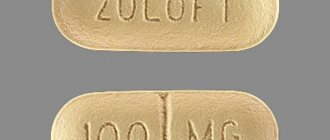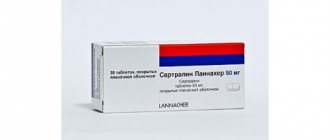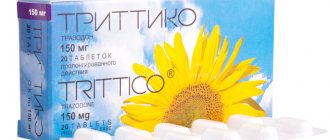The drug called Zoloft or Sertraline is quite well known in our country.
It is an antidepressant that is a serotonin reuptake inhibitor. The dosage of the drug is selected strictly individually based on examinations, the person’s health status, clinical picture and diagnosis. The drug is often prescribed in combination with antipsychotics to treat depression and other disorders such as obsessive-compulsive disorder.
It is important that this drug can only be combined with antidepressants belonging to different groups.
pharmachologic effect
Antidepressant, a powerful specific inhibitor of serotonin (5-HT) reuptake in neurons.
It has a very weak effect on the reuptake of norepinephrine and dopamine. In therapeutic doses, it blocks the uptake of serotonin in human platelets. Does not have a stimulating, sedative or anticholinergic effect. Due to the selective inhibition of 5-HT uptake, sertraline does not enhance adrenergic activity. Sertraline has no affinity for muscarinic cholinergic receptors, serotonin, dopamine, histamine, GABA, benzodiazepine and adrenergic receptors. Sertraline does not cause drug dependence and does not cause weight gain with long-term use.
Pharmacokinetics
Suction
Absorption is high, but at a slow rate. When taking the drug simultaneously with food, bioavailability increases by 25%, Cmax increases by 25% and Tmax decreases.
In humans, when taking sertraline at a dose of 50 to 200 mg 1 time / day for 14 days, Cmax was achieved 4.5-8.4 hours after administration. Cmax and AUC are proportional to the dose within the range of 50-200 mg of sertraline 1 time / day for 14 days, while the linear nature of the pharmacokinetic dependence is revealed.
Distribution
Plasma protein binding is about 98%.
According to the final T1/2, an approximately twofold cumulation of the drug is observed until the onset of equilibrium concentrations after 1 week of treatment (dose 1 time/day).
Metabolism
Sertraline undergoes active biotransformation during the “first pass” through the liver. The main metabolite found in plasma, N-desmethylsertraline, is significantly inferior (about 20 times) to sertraline in activity in vitro and is virtually inactive in in vivo models of depression.
Sertraline and N-desmethylsertraline are actively biotransformed.
Removal
The average T1/2 of sertraline in young and elderly men and women is 22-36 hours. T1/2 of N-desmethylsertraline varies between 62-104 hours. Metabolites are excreted in feces and urine in equal quantities. Only a small part of the drug (less than 0.2%) is excreted unchanged in the urine.
Pharmacokinetics in special clinical situations
The pharmacokinetic profile in adolescents and elderly patients does not differ significantly from that in patients aged 18 to 65 years.
The pharmacokinetics of sertraline in children with OCD have been shown to be similar to those in adults (although the metabolism of sertraline is somewhat more active in children). However, given the lower body weight in children (especially those aged 6-12 years), it is recommended to use the drug in a lower dose to avoid excessive plasma levels.
In patients with liver cirrhosis, T1/2 of the drug and AUC increase compared to those in healthy people.
Lifestyle modification method (alternative therapy)
An alternative method of stopping the antidepressant Zoloft: how to stop taking it immediately after completing the therapeutic course when a lasting positive result is achieved.
- Exercise daily for 30 minutes. Regular physical exercise promotes the production of endorphins, which strengthen the nervous system and normalize the psyche. Relieves depression and other central nervous system diseases.
- Healthy diet. Introduce into your diet foods containing Omega-3 fatty acids as an additional means of treating depression: cabbage, spinach, walnuts, fatty fish, soybean oil. It is possible to use Omega-3 in its pure form (purchased at the pharmacy).
- Maintain a sleep schedule by going to bed and waking up at the same time. For proper rest, avoid overexcitement, drinking alcohol and coffee before bed.
- Exposure to the sun more often can reduce depression symptoms by increasing serotonin levels under the influence of sunlight.
- Use the services of a psychotherapist to learn techniques for managing thoughts, stress, and behavior.
- Acupuncture and meditation. Additional methods of influencing nerve centers and controlling self-awareness. Deep, slow breathing increases oxygen flow and reduces anxiety.
Still have questions about how to reduce the side effects of taking Zoloft and how to stop taking it? Professional consultation in our clinic will help solve them!
Dosage
The drug is administered orally, 1 time/day in the morning or evening. The tablets can be taken regardless of meals.
For depression and OCD
treatment begins with a dose of 50 mg/day.
Treatment of panic disorders, PTSD and social phobia
start with a dose of 25 mg/day, which is increased after 1 week to 50 mg/day. The use of the drug according to this regimen can reduce the incidence of early undesirable treatment effects characteristic of panic disorder.
If the effect of using sertraline in patients at a dose of 50 mg/day is insufficient, the daily dose can be increased. The dose should be increased at intervals no more than once per week to a maximum recommended dose of 200 mg/day.
Initial effects may be seen within 7 days of starting treatment, but full effects are usually achieved within 2-4 weeks (or even longer for OCD).
During long-term maintenance therapy
the drug is prescribed in the minimum effective dose, which is subsequently changed depending on the clinical effect.
In children and adolescents aged 13-17 years
with
OCD,
treatment with Zoloft should begin with a dose of 50 mg/day.
In children aged 6-12 years,
treatment for OCD begins with a dose of 25 mg/day, after 1 week it is increased to 50 mg/day. Subsequently, if the effect is insufficient, the dose can be increased in steps of 50 mg/day up to 200 mg/day as needed. In clinical trials in patients with depression and OCD aged 6 to 17 years, it was shown that the pharmacokinetic profile of sertraline was similar to that in adults. To avoid overdose, when increasing the dose above 50 mg, it is necessary to take into account the lower body weight in children compared to adults.
T1/2 of sertraline is approximately 1 day, so dose changes should occur at intervals of at least 1 week.
In elderly patients
the drug is used in the same doses as in younger patients.
The drug should be used with caution in patients with liver disease
.
In patients with liver failure
, use lower doses or increase the interval between doses of the drug.
The drug is largely metabolized in the body. Only a small amount of the drug is excreted unchanged in the urine. As expected given the negligible renal excretion of sertraline, its dose was adjusted depending on the severity of renal failure
not required.
Content:
- Drug withdrawal syndrome: when and why it occurs
- Zoloft dose reduction method
- Lifestyle modification method (alternative therapy)
To treat depression and anxiety disorders, panic attacks and other central nervous system diseases, antidepressants are prescribed that increase the level of serotonin, which is responsible for emotions and behavior. One of its representatives is Zoloft. How to stop taking it in order to eliminate or alleviate side effects when stopping the drug? To do this, the doctor prescribes an appropriate method of gradually stopping the antidepressant until you completely stop taking it.
Side effects
From the digestive system:
dyspeptic symptoms (flatulence, nausea, vomiting, diarrhea, constipation), abdominal pain, pancreatitis, dry mouth, hepatitis, jaundice, liver failure, decreased appetite (rarely increased), even anorexia; rarely, with long-term use - an asymptomatic increase in transaminase activity in the blood serum occurs. Discontinuation of the drug in this case leads to normalization of enzyme activity.
From the cardiovascular system:
palpitations, tachycardia, arterial hypertension.
From the musculoskeletal system:
arthralgia, muscle cramps.
From the central nervous system and peripheral nervous system:
extrapyramidal disorders (dyskinesia, akathisia, teeth grinding, gait disturbance), involuntary muscle contractions, paresthesia, fainting, drowsiness, headache, migraine, dizziness, tremor, insomnia, anxiety, agitation, hypomania, mania, hallucinations, euphoria, nightmares, psychosis, decreased libido, suicide, coma.
From the respiratory system:
bronchospasm, yawning.
From the urinary system:
enuresis, incontinence or urinary retention.
From the reproductive system:
sexual dysfunction (delayed ejaculation, decreased potency), galactorrhea, gynecomastia, menstrual irregularities, priapism.
From the senses:
blurred vision, mydriasis, ringing in the ears.
From the endocrine system:
hyperprolactinemia, hypothyroidism, syndrome of inappropriate ADH secretion.
Dermatological reactions:
redness of the skin or flushing of the face, alopecia, photosensitivity reaction, purpura, increased sweating.
Allergic reactions:
urticaria, pruritus, anaphylactoid reaction, angioedema, periorbital edema, facial edema, rarely Stevens-Johnson syndrome and epidermal necrolysis.
From the hematopoietic system:
possible development of leukopenia and thrombocytopenia.
Other:
weight loss or gain, peripheral edema, increased serum cholesterol levels, weakness, bleeding (including nasal, gastrointestinal or hematuria). Rare cases of withdrawal syndrome have been described when stopping treatment with sertraline. Paresthesia, hypoesthesia, symptoms of depression, hallucinations, aggressive reactions, psychomotor agitation, anxiety, or symptoms of psychosis may appear that cannot be distinguished from the symptoms of the underlying disease.
Drug withdrawal syndrome: when and why it occurs
When you stop taking a medication that affects brain processes, so-called withdrawal syndrome sometimes occurs. The first signs appear after 2-3 days. If you miss a dose once, they are sometimes observed the next day. The reason for their occurrence is a change in the activity of brain neurons, which need time to reorganize their activity without the participation of a drug.
Zoloft accumulates in the cells of the body, and the method of quitting it is to gradually reduce the dose until complete elimination. Moreover, the regimen depends on the duration of treatment and the dose taken at that time.
Symptomatic manifestations will disappear only after the drug and its metabolites are completely removed from the blood, within a period of two weeks to 2-3 months, in rare cases - even longer. Treating them separately is unsuccessful. In the worst case scenario, they resume taking Zoloft, and then gradually reduce the dose to get off it.
The name of the withdrawal syndrome is not entirely correct: the antidepressant does not cause addiction , and undesirable manifestations are associated exclusively with the restructuring of the nervous system in the new conditions of abandoning it.
Overdose
Symptoms:
no severe symptoms were detected in case of an overdose of sertraline even when using the drug in high doses. However, when administered simultaneously with other drugs or alcohol, severe poisoning can occur, including coma and death.
In case of overdose, manifestations of serotonin syndrome are possible (nausea, vomiting, drowsiness, tachycardia, agitation, dizziness, psychomotor agitation, diarrhea, increased sweating, myoclonus and hyperreflexia).
Treatment:
There are no specific antidotes. Intensive supportive care and constant monitoring of vital body functions are required. Inducing vomiting is not recommended. The administration of activated carbon may be more effective than gastric lavage. The airway must be maintained. Sertraline has a large Vd, and therefore increased diuresis, dialysis, hemoperfusion or blood transfusion may be ineffective.
Literature:
- Dynamics of anxious depression in the treatment of modern antidepressants (tianeptine (Coaxil), sertraline (Zoloft): dissertation ... candidate of medical sciences: 00.14.18 / Maksimova Natella Maratovna; [Place of defense: Moscow Research Institute of Psychiatry]. - Moscow, 2003. - 161 p.
- Be free. Life without anxiety and phobias: workbook: [16+] / Edmund J. Bourne; [translation from English by Irina Zhandarova and others]. — St. Petersburg: Ves, 2021. – 603 p.
- Clinical use of sertraline and afobazole in patients with comorbid depression and anxiety in the post-stroke period / Butko D. Yu., Strelnikov A. A., Kotelnikova T. L., Davydov A. T., Zagrebelny I. A. / 2007 / Psychopharmacology and biological narcology




